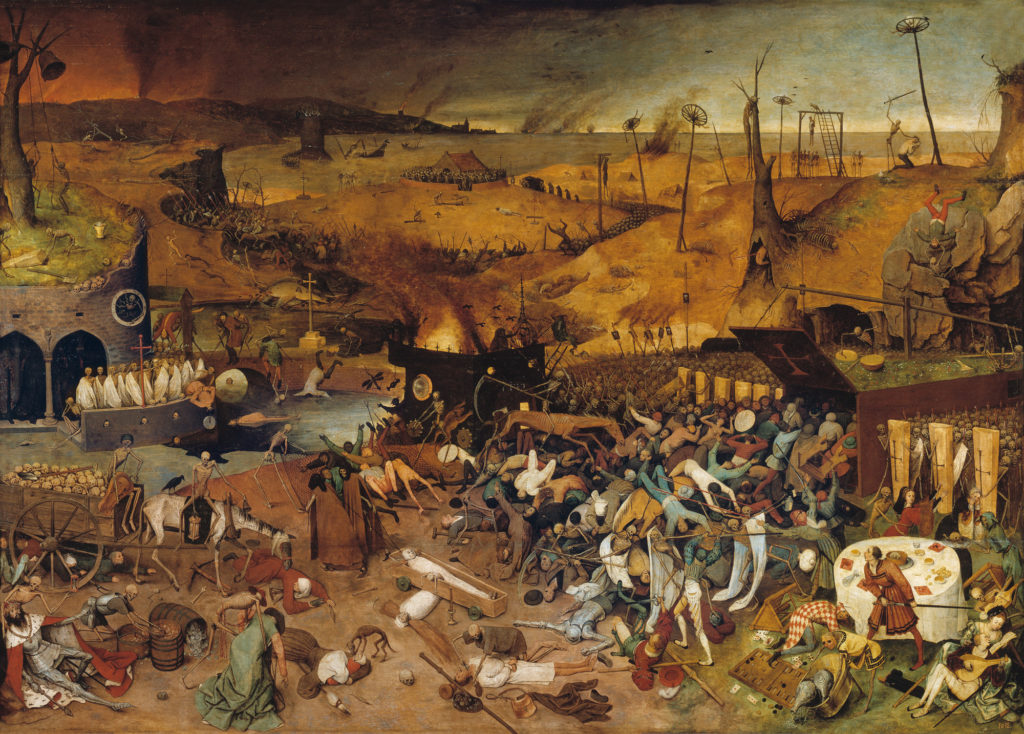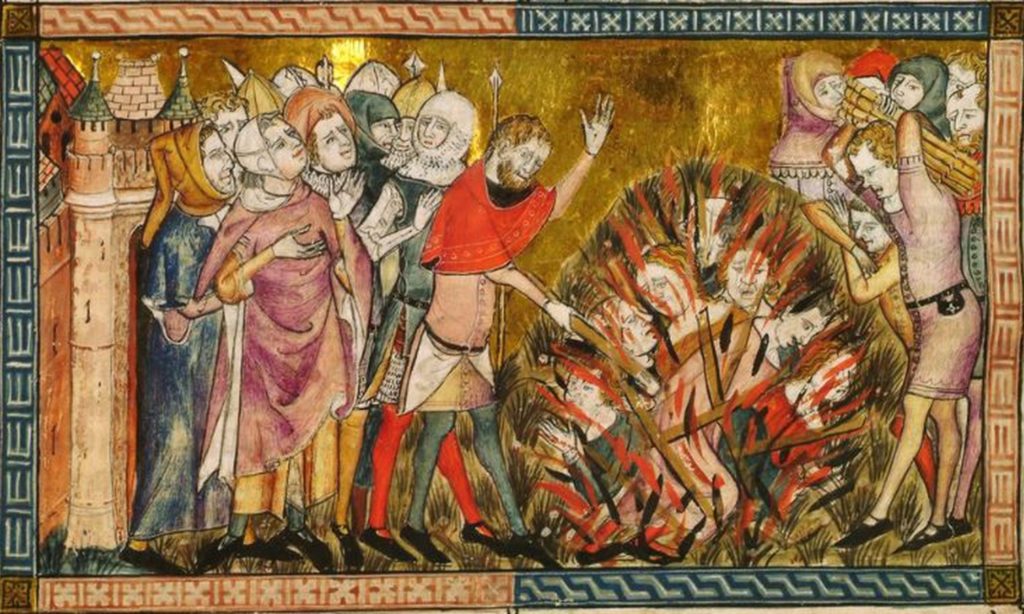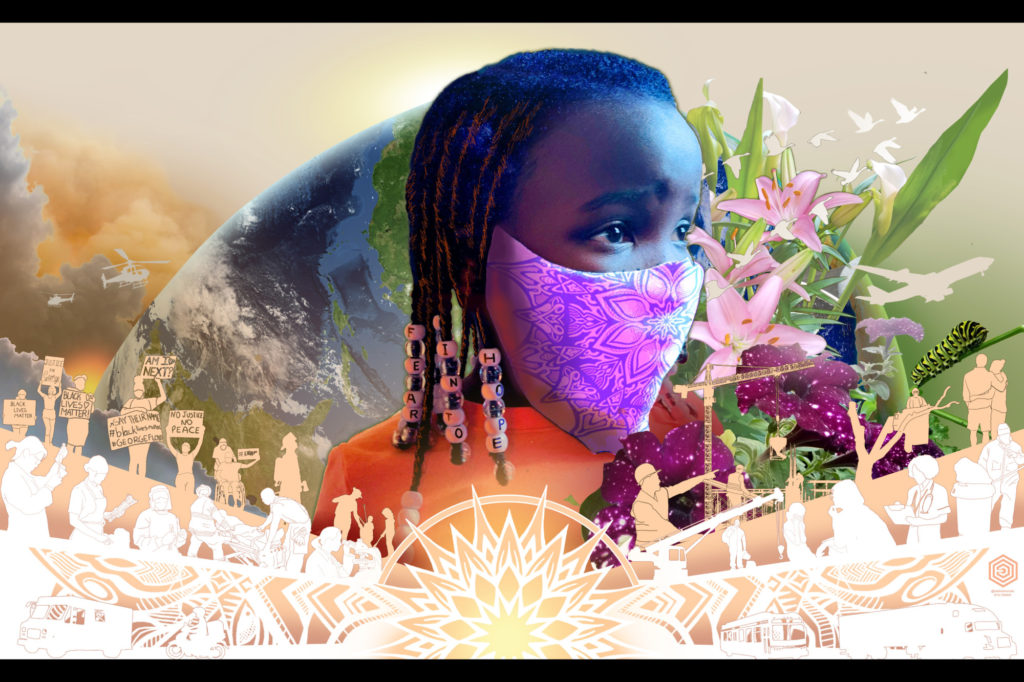Historical Perspectives in Art
The Value of Art History in a Pandemic: Teaching as a Healing Force
By Siobhan M. Conaty, PhD
In the midst of this historic pandemic, there is no more important time in our profession, in our lives, in our world—to embrace the humanities. [They] provide the critical tools to navigate uncertainty, tolerate ambiguity, and broaden moral imagination.
—Sarah R. Blanton, “What is saving you now?” JHR, Spring 2020
In March 2020, I joined with other educators across the nation in a collective pause enforced by the global COVID-19 pandemic. As universities shut down, we quickly packed up our books and faced the uncertainty and disruption of well-laid curricular plans in the sudden shift to teaching online. While I was able to tweak and adjust most of the courses I taught, I found myself scrambling to completely change the planned coursework for my undergraduate Introduction to Art History class at La Salle University. I was disappointed that my original plans for students to use campus virtual reality technology to research and “visit” global archeological and architectural sites was not possible while teaching remotely. I used this time to reflect on what I could do as an art historian to help my students process the fear and chaos happening around them. How could I challenge my teaching during this unprecedented time by illustrating to my students how the humanities help us make meaning and find understanding during periods of unrest and ambiguity?
In this article, I share how art history as a health humanities discipline can provide two uniquely different (yet equally important) methods for students reckoning with a health crisis. One method involves a critical reading of pandemic images in order to learn from the past; the other looks to art as a powerful instrument to help contend with the chaos—providing restorative forms of healing. At the same time, I relate my own experiences navigating uncertainty as an art historian and health humanities scholar teaching during a public health crisis.
Molding a Crisis Curriculum
My initial instinct was to begin with the rich visual history of images depicting outbreaks of the plague from the Medieval and Renaissance periods to the activist art of the AIDS epidemic in the late 20th century, and apply art history skills—learning to read an image or object and analyze it within a social and historical context of its time. Confident that this was a great way for students to learn from the past to better understand our present situation, I began to prepare assignments that probed social and economic inequities of public health crises. I planned to start with a close reading of the chaotic scene of death of all social classes depicted in Pieter Bruegel the Elder’s painting, The Triumph of Death (1562) (Fig. 1) in relation to excerpts from Giovanni Boccaccio’s The Decameron (1351). In this text, Boccaccio described the relative privilege of the wealthy during the 14th-century plague in Florence, noting “the plight of the lower class and, perhaps, a large part of the middle class was even more pathetic,”1 as they did not have the means to leave the city and thus fell sick and died by the thousands. Breugel’s painting and Boccaccio’s text would then be discussed in relation to Nicholas Casey’s article, “College Made Them Feel Equal. The Virus Exposed How Unequal Their Lives Are,”2 to bring the discussion of economic disparities closer to home.

Figure 1: Brueghel, Pieter the Elder (c. 1525-1569). The Triumph of Death. Ca. 1562. Oil on panel. 1.17 x 162m. Copyright of the image Museo Nacional del Prado / Art Resource, NY.
Additional opportunities for comparison to contemporary issues can be found in The Chronicles of Gilles Li Muisis, a 14th-century French manuscript chronicling Abbot Guilles li Muisis’ description of the plague in Tournai (modern-day Belgium). In this case, students would compare Pierart dou Tielt’s stark illustration (Fig. 2) of the city dealing with the problem of overflow and burial of dead bodies3 to contemporary photographs of mass burials across the world due to Covid-19 in Alan Taylor’s Vanity Fair article, “An Unimaginable Toll.”4

Figure 2: Miniature by Pierart dou Tielt,Chronicles ofGilles li Muisis (Tournai, c. 1353). The People of Tournai Bury Victims of the Black Death. ms. 13076-13077 fol. 24v. Bibliotheque royal de Belgique.
Another image from the same manuscript, called The Strasbourg Massacre (Fig. 3), highlights a brutal lesson from history—the desire of some groups to assign blame and malicious intent to the spread of the disease. In this case, Christians accused Jews of the purposeful spread of the plague by poisoning water sources, ultimately leading to the extermination of entire Jewish communities.5 While these images are painful to look at and learn about, they provoke compelling discussions on bigotry and intolerance when compared to contemporary conspiracy theories and overt racism toward Asian communities, particularly the Chinese, regarding the origin and spread of COVID-19. This is the power of art history; we can read about catastrophic events and the horrific failings of humankind, but seeing the images packs an emotional punch and promotes a profound reckoning of just how little human nature has changed. Learning to read these images critically and contextually gives students the knowledge and tools to challenge current social, racial, and economic disparities in our current pandemic.

Figure 3: Miniature by Pierart dou Tielt,Chronicles ofGilles li Muisis (Tournai, c. 1353). The Strasbourg Massacre: Jews Burned to Death in Strasbourg during the Black Death, ms. 13076-13077 fol. 24v. Bibliotheque royal de Belgique.
Choosing a Healing Approach
And yet, as I planned these new class sessions charged with critical comparisons to social and public health issues of the current COVID-19 crisis, I wasn’t prepared for how difficult it was to analyze graphic images of death, disease, and massacres, along with heartbreaking images of loss, sorrow, and mourning while living through an actual pandemic. I quickly realized that if the material was hard for me to digest in my own state of anxiety during the pandemic, I couldn’t impose this content upon my students. Recognizing certain methods would not serve my students at this time, I put aside my need to demonstrate the critical rigor of my discipline and revised the rest of the semester to focus on the study of art as a powerful instrument for healing, comfort, and joy. That said, I didn’t throw away my prior work; I will use this material in class at a less stressful time. In fact, after reflecting on the role of the humanities in recognizing the importance of dealing with the unknown, I decided to acknowledge my own uncertainties and share this experience with my students.
In our first remote class, I told my students the story of my initial plans, showing them plague images as examples and described my plans to use these works of art to think critically about our current situation. I acknowledged my own struggle with the material and my decision to focus instead on the healing component of art. I shared that my course goals had shifted; I now wanted students to understand how art can provide healing, comfort, and humor in addition to illustrating the inequities of its time. With this in mind, I divided the remainder of the course into three modules on the following topics: Art and Personal Health, Art and Public Health, and Art in a Time of Crisis.
As a health humanities scholar, I also applied some of Peterkin and Skorzewska’s key goals for health humanities in postgraduate medical education to this undergraduate course: providing a unique space to question, analyze, and critique contemporary practice while at the same time encouraging self-reflection and cultivating skills of reflexivity, in order to foster a greater understanding of the human condition.6 The following is a brief description and list of some resources used in these modules.
Art and Personal Health
In this first section of the course, I assigned short and easily-accessible readings introducing the concepts and studies that demonstrate that looking at art and visiting an art museum benefits one’s physical health, mental health, and emotional intelligence. Students were asked to read and reflect upon these studies, and follow up with a “lab experiment”—a virtual visit to the Metropolitan Museum of Art’s (the MET) Temple of Dendur (via their MET360 project) in order to examine and reflect upon their personal response while viewing art in the midst of a pandemic lockdown.
For most of my students (undergraduate non-majors, taking the course to fulfill a core requirement), this was the first time they heard of or even thought about these ideas connecting art and health. I knew I was on the right track when their written responses contained exclamations of surprise, wonder, requests for more information on certain studies, and an overall reaction of finding joy and peace while virtually wandering through the MET, a museum most had never visited in real life.
Resources:
- Why Going to an Art Museum Could Be as Good for You as Exercise
- Doctors to Prescribe Museum Visits in Pioneering Treatment
- Study Finds Med Students Who Make Time for Art Have More Empathy
- Researchers Have Found That Visiting Art Museums Can Offer Significant Relief for People Living With Dementia
- Visit NYC’s Metropolitan Museum of Art’s Egyptian Temple of Dendur via The Met 360
Art and Public Health
In this section, students investigated the connections between public art and public health. La Salle University in Philadelphia, PA is home to one of the most impressive mural arts programs in the country. We focused on Mural Arts Philadelphia (MAP) and their Porch Light initiative. Students considered Porch Light’s core message to “[work] closely with communities to uplift public art as an expression of community resilience and a vehicle of personal and community healing.”7 In a series of short, accessible readings and a video, students learned about the connection between public art and public health outcomes, and, more specifically, the effects of the Porch Light program on communities in Philadelphia. The Yale School of Medicine studied the impact and health outcomes in Porch Light communities and found increases in social cohesion and trust among neighbors, decreases in stigma toward individuals with mental health or substance-abuse issues, and an increase in the quality of the walking environment and perceptions of safety.7
After a written assignment reflecting on the connection between public murals to community health and wellness, students were asked to create their own “Art & Public Health Mural Arts Tour.” Using the Mural Arts Philadelphia website as their source, students created a PowerPoint tour with images, maps, and accompanying text, explaining why they picked a specific mural and how it related to community health and well-being. Their final slide involved a short critical thinking piece with the following prompts: How much did you know about Mural Arts Philadelphia before this assignment? How much did you know about Public Health concerns? Has this assignment changed the way you think about the role of city murals? Will you look at or interact with them differently? How so?
Resources:
- Public Art as Public Health
- The Porch Light Initiative Video – Community Healing Through Art
- Philadelphia Mural Arts: Porch Light Program
- Mural Arts Philadelphia website
Art in a Time of Crisis
Having set up an introductory framework on the research connecting art and health, the final summative assignment of the semester allowed students to apply what they learned to their own interests. This project was inspired by the phenomena happening in the creative world at that moment, where artists (and musicians, actors, writers, poets, etc.) were making their work public and free for all to provide joy, comfort, and entertainment during the global shutdown. The primary question of inquiry for this assignment was: what kind of creative work is being made and shared publicly right now while we are in lockdown and the world is reeling from fear, anxiety, and grief? Their task was to search their social-media communities to curate their own exhibition of art (defined in a broad sense) made in response to COVID-19 that offered some form of respite. The narrative accompanying their selections had to connect to the ideas and concepts discussed in the previous two modules with these prompts: Why did you select this creative work? How does this work of art relate to personal health, wellness, or public health?
I shared my own list as a model for the assignment: Amplifier’s Free Downloadable art celebrating first responders and public health messages, The Getty Museum Challenge recreating famous works of art, Yo-Yo Ma’s Songs of Comfort, Lin Manuel Miranda & Andrew Lloyd Weber’s “Play-off” on Twitter, and Couple in Lockdown Create Tiny Art Museum for Their Gerbils, and noted that these examples in some way created a “biographic picture” of my interests and personality that I typically don’t get to share with students. Their exhibits were fabulous, with subjects ranging from street art, tattoos, video-game imagery, comics, poetry, songs, and concerts, to many funny and moving TikTok videos. The results were wonderful, and a joy to grade (a somewhat rare experience at the end of a semester).
Reflections
This final project allowed me to get to know my students (and they me) on a level that would not have happened in the typical face-to-face classroom environment, which is contrary to traditional thinking about online teaching but makes sense when considering the nature of art. Sarah Blanton, Editor-in-Chief of JHR, noted in her Spring 2020 editorial that through art, “we find that connection of shared experiences, and perhaps we see each other a little more clearly, more compassionately.”8 This class made me rethink how I teach, and what I teach in the introductory course. The unexpected switch to remote teaching forced me to think about content and assessment in ways that I had not considered before.
I struggled to leave behind traditional art history methods (visual analysis and critical social/historical studies) to embrace projects that involved studying art as “simply” a form of joy and comfort beneficial to one’s health. This resistance comes from a long history of art historians having to defend and explain the rigor and methods of the discipline to others, particularly in the medical humanities, where the arts can be pigeon-holed as a vehicle for empathy and therapy. I now realize my reluctance was limiting to myself, but more importantly, to my students. I found that there is time for both rigorous methods and compassionate, joyful pedagogy. As a result, these students left my class with more than the typical set of art history skills, just as I left class with a better set of teaching skills.
It is Blanton’s idea of art as a method of seeing each other more compassionately that stays with me as I prepare for my Fall 2020 courses in light of the continuing pandemic and the additional public health crisis illuminated by the Black Lives Matter movement. I am planning modules for my students to engage with art critically, culturally, to have the difficult discussions, and to see each other more compassionately. Once again, I will use art as a means of addressing and interrogating issues of health and social injustice, using murals like Eric Okdeh’s The World to Come (Mural Arts Philadelphia, forthcoming, 2021) (Fig. 4) to encourage the trajectory of discussion, understanding, activism, and the ultimate goal: change.

Figure 4: Eric Okdeh, The World to Come, (forthcoming Mural Arts Philadelphia, 2021) Eric Okdeh Instagram: @okdehmurals
References
- Boccaccio G. The Decameron. Trans. Mark Musa and Peter E. Bondanella, eds. New York, NY: W.W. Norton & Company; 1977: 5.
- Casey N. College made them feel equal. The virus exposed how unequal their lives are. New York Times. April 4, 2020. Available at: https://www.nytimes.com/2020/04/04/us/politics/coronavirus-zoom-college-classes.html.
- Boeckl CM. Images of Plague and Pestilence: Iconography and Iconology. Missouri: Truman State University Press; 2000: 16.
- Taylor A. An unimaginable toll. Atlantic. April 8, 2020. Available at: https://www.theatlantic.com/photo/2020/04/coronavirus-unimaginable-toll-photos/609652/.
- Tuchman, BW. A Distant Mirror: The Calamitous 14th Century. New York, NY: Alfred A. Knopf; 1978: 121.
- Peterkin A. Skorzewska A. Health Humanities in Postgraduate Medical Education. Oxford: Oxford University Press; 2018: 10-11.
- Porch Light Program, Department of Behavioral Health and Intellectual disAbility Services. Available at: https://dbhids.org/wp-content/uploads/2016/01/Community_Mural-Arts_Porch-Light-Program-One-Pager-Dec-2015.pdf.
- Blanton S. What is saving you now? J Hum Rehabil. Spring 2020. Available at: https://www.jhrehab.org/2020/05/08/jhr-spring-2020-editorial-what-is-saving-you-now/.



 Member since 2019 | JM14274
Member since 2019 | JM14274


NO COMMENT